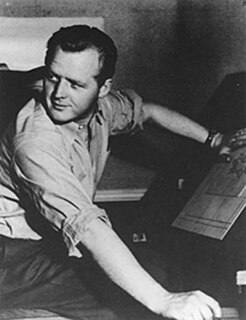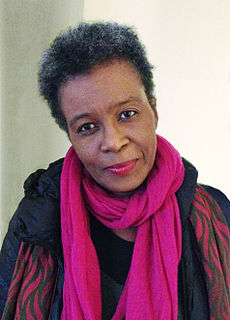
Millard Owen Sheets was an American artist, teacher, and architectural designer. He was one of the earliest of the California Scene Painting artists and helped define the art movement. Many of his large-scale building-mounted mosaics from the mid-20th century are still extant in Southern California. His paintings are in the Metropolitan Museum of Art and the Whitney Museum in New York, the Chicago Art Institute, the National Gallery in Washington D.C.; and the Los Angeles County Museum.

Claudia Rankine is an American poet, essayist, playwright, and the editor of several anthologies. She is the author of five volumes of poetry, two plays, and various essays.
Judy Fiskin is an American artist working in photography and video, and a member of the art school faculty at California Institute of the Arts. Her videos have been screened in the Documentary Fortnight series at the Museum of Modern Art in New York, at the Los Angeles County Museum of Art, the Hammer Museum in Los Angeles, and at the J. Paul Getty Museum in Los Angeles; her photographs have been shown at MOCA, the Museum of Contemporary Art in Los Angeles, at the Getty Museum in Los Angeles, at The New Museum in New York City, and at the Pompidou Center in Paris.
John Mason was an American artist who did experimental work with ceramics. Mason's work focused on exploring the physical properties of clay and its "extreme plasticity". One of a group of artists who had studied under the pioneering ceramicist Peter Voulkos, he created wall reliefs and expressionistic sculptures, often on a monumental scale.

Ronald "Ron" Davis is an American painter whose work is associated with geometric abstraction, abstract illusionism, lyrical abstraction, hard-edge painting, shaped canvas painting, color field painting, and 3D computer graphics. He is a veteran of nearly seventy solo exhibitions and hundreds of group exhibitions.

Karl J. Benjamin was an American painter of vibrant geometric abstractions, who rose to fame in 1959 as one of four Los Angeles-based Abstract Classicists and subsequently produced a critically acclaimed body of work that explores a vast array of color relationships. Working quietly at his home in Claremont, CA, he developed a rich vocabulary of colors and hard-edge shapes in masterful compositions of tightly balanced repose or high-spirited energy. At once intuitive and systematic, the artist is, in the words of critic Christopher Knight, "a colorist of great wit and inventiveness."
Roger Edward Kuntz was a highly accomplished Southern California landscape painter and a member of the Claremont Group of painters - professors and graduates of Pomona College, Scripps College, and the Claremont Graduate School. A figurative artist with an eye for abstract form, he won critical acclaim for striking compositions that transform an unusual array of subjects, including tennis players, domestic interiors, freeways, road signs, bathtubs and the Goodyear Blimp. A retrospective exhibition of his work, at the Laguna Art Museum in Laguna Beach, CA in 2009, was aptly titled "Roger Kuntz: The Shadow Between Representation and Abstraction". In the exhibition catalogue, curator Susan M. Anderson wrote: "Kuntz's work of the late 1950s and early 1960s quintessentially embodied the experimentation, fragmentation, and paradox in American culture of the time."
Pacific Standard Time: Art in L.A., 1945–1980 was a scholarly initiative funded by the J. Paul Getty Trust to historicize the contributions to contemporary art history of artists, curators, critics, and others based in Los Angeles. Planned for nearly a decade, PST, as it was called, granted nearly 60 organizations throughout Southern California a total of $10 million to produce exhibitions that explored the years between 1945 and 1980. Underscoring the significance of this project, art critic Roberta Smith wrote in The New York Times:
Before [PST], we knew a lot [about the history of contemporary art], and that lot tended to greatly favor New York. A few Los Angeles artists were highly visible and unanimously revered, namely Ed Ruscha and other denizens of the Ferus Gallery, that supercool locus of the Los Angeles art scene in the 1960s, plus Bruce Nauman and Chris Burden, but that was about it. After, we know a whole lot more, and the balance is much more even. One of the many messages delivered by this profusion of what will eventually be nearly 70 museum exhibitions is that New York did not act alone in the postwar era. And neither did those fabulous Ferus boys.
James Hayward is a contemporary abstract painter who lives and works in Moorpark, California. Hayward's paintings are usually divided in two bodies of work: flat paintings (1975-1984) and thick paintings. He works in series, some of which are ongoing, and include The Annunciations, The Stations of the Cross, the Red Maps, Fire Paintings, Smoke Paintings, Sacred and Profane and Nothing's Perfect series.

Polly E. Apfelbaum is an American contemporary visual artist, who is primarily known for her colorful drawings, sculptures, and fabric floor pieces, which she refers to as "fallen paintings". She currently lives and works in New York City, New York.
Phyllis Green is an artist whose practice involves sculpture, video and installation art. Based in Santa Monica, she has received a Guggenheim Fellowship, as well as grants from the City of Santa Monica, California Community Foundation, Durfee Foundation, Pollock-Krasner Foundation, California Arts Council, National Endowment for the Arts, Canada Council and British Columbia Cultural Fund. In 1996, she was among the first to be awarded a C.O.L.A. grant by the City of Los Angeles. In 2000, she was appointed to the Santa Monica Arts Commission, serving, as its chair from 2004 to 2006. She is married to the photographer Ave Pildas.

Ken Gonzales-Day is a Los Angeles-based conceptual artist best known for interdisciplinary projects that examine the historical construction of race, identity, and systems of representation including lynching photographs, museum display and street art. His widely exhibited "Erased Lynching" photographic series and book, Lynching in the West: 1850-1935 (2006), document the absence in historical accounts of the lynching of Latinos, Native Americans and Asians in California's early history. The series has toured in traveling exhibitions staged by the Los Angeles County Museum of Art (LACMA), Smithsonian Institution and Minnesota Museum of American Art, and appeared at the Tamayo Museum, Generali Foundation (Vienna) and Palais de Tokyo in Paris, among other venues.
Charles Gaines is an American artist whose work interrogates the discourse of aesthetics, politics, and philosophy. Taking the form of drawings, photographic series and video installations, the work consistently involves the use of systems, predominantly in the form of the grid, often in combination with photography. His work is rooted in Conceptual Art – in dialogue with artists such as Sol LeWitt, Lawrence Weiner and Mel Bochner – and Gaines is committed to its tenets of engaging cognition and language. As one of the only African-American conceptual artists working in the 1970s, a time when political expressionism was a prevailing concern among African-American artists, Gaines was an outlier in his pursuit of abstraction and non-didactic approach to race and politics. There is a strong musical thread running through much of Gaines' work, evident in his repeated use of musical scores as well in his engagement with the idea of indeterminacy, as similar to John Cage and Sol LeWitt.

Sheila Pinkel is an American visual artist, activist and educator whose practice includes experimental light studies, photography, conceptual and graphic works, and public art. She first gained notice for cameraless photography begun in the 1970s that used light-sensitive emulsions and technologies to explore form; her later, socially conscious art combines research, data visualization, and documentary photography, making critical and ethical inquiries into the military-industrial complex and nuclear industry, consumption and incarceration patterns, and the effects of war on survivors, among other subjects. Writers identify an attempt to reveal the unseen—in nature and in culture—as a common thread in her work.

The American Museum of Ceramic Art (AMOCA) is an art museum for ceramic art, located in Pomona, California. Founded in 2003 as a nonprofit organization, the museum exhibits historic and contemporary ceramic artwork from both its permanent collection of 10,000 objects and through temporary rotating exhibitions.
Jim Isermann is an American artist. He is based in Palm Springs and Guerneville, California. In 1977 he graduated from University of Wisconsin-Milwaukee and then received an MFA from CalArts in 1980. His artwork has focused on post-war industrial design and architecture. He has participated in numerous exhibitions in art galleries and museum, and has also created large scale commissioned projects utilizing industrial manufacturing processes. His work has been presented in solo exhibitions at Richard Telles, Los Angeles, Praz-Delavallade, Paris (2010), Corvi-Mora, London (2011), Mary Boone Gallery, New York and others. Recent commissioned projects include works for the Hammer Museum in Los Angeles, CA, Yale University Art Museum in New Haven, CT, University of California, Riverside, Los Angeles Metro, and an installation for the Cowboys Stadium in Dallas, TX.

Prometheus is a fresco by Mexican muralist José Clemente Orozco depicting the Greek Titan Prometheus stealing fire from the heavens to give to humans. It was commissioned for Pomona College's Frary Dining Hall and completed in June 1930, becoming the first modern fresco in the United States. It has received widespread critical acclaim.
The Benton Museum of Art at Pomona College, known colloquially as the Benton, is an art museum at Pomona College in Claremont, California. It was completed in 2020, replacing the Montgomery Art Gallery which had been home to the Pomona College Museum of Art (PCMA) since 1958. It houses a collection of approximately 15,000 works, including Italian Renaissance panel paintings, indigenous American art and artifacts, and American and European prints, drawings, and photographs. The museum is free to the public.

Steven Hull is an American artist based in Los Angeles. His projects cross boundaries typically drawn between personal and collaborative work, disciplines like painting, sculpture and installation art, and artistic fields including writing, music, art, illustration, design and performance. In his personal work, he frequently creates immersive, multimedia tableaux and exhibitions that Los Angeles Times critic Christopher Knight described as "carnivalesque hybrids of painting and sculpture whose chief aim is to turn visions of the conventional world upside down." He often mixes opposing artistic styles, irreverent conceptual strategies, and tones that range from playful to alienated or politically pointed. His collaborations include several artist-writer publications, including I’m Still In Love With You (1998–9), Song Poems, and AB OVO (2005); he also co-founded the artist-run space La Cienegas Projects and established Nothing Moments Press, which produced and published "Nothing Moments" (2007), a set of 24 limited-edition book collaborations between writers, artists and designers. These projects have been presented at MOCA at the Pacific Design Center, Rosamund Felsen Gallery, and Festival Supreme, among other venues. Hull has received a Joan Mitchell Foundation award for painting (2009) and a Louis Comfort Tiffany Foundation award (2001). He is married to artist Tami Demaree.
Elizabeth Armstrong is an American curator of contemporary and modern art. Beginning in the late 1980s, she served in chief curatorial and leadership roles at the Walker Art Center, Museum of Contemporary Art, San Diego, Orange County Museum of Art (OCMA), Minneapolis Institute of Arts and Palm Springs Art Museum. She has organized numerous touring exhibitions and catalogues that gained national and international attention; among the best known are: "In the Spirit of Fluxus", "Ultrabaroque: Aspects of Post-Latin American Art", and "Birth of the Cool: California Art, Design, and Culture at Midcentury". She is also known for organizing three California Biennials (2002–6) and notable exhibitions of David Reed and Mary Heilmann. Armstrong's curatorial work and publications have been recognized by the Andy Warhol Foundation, the Center for Curatorial Leadership, the Getty Foundation Pacific Standard Time project and the National Endowment for the Arts, among other organizations.













